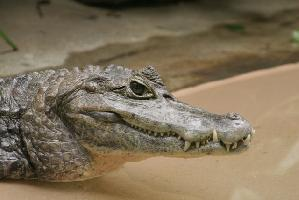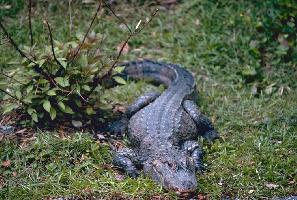
Súlyok és méretek
| Hossz | 1,4-tól 3-ig m |
|---|
Állatleírás
The Spectacled Caiman (Caiman crocodilus) is a fascinating and adaptable species of crocodilian found in Central and South America. Named for the bony ridge between its eyes, which resembles a pair of spectacles, this creature is a remarkable example of nature's adaptability and diversity. The spectacled caiman thrives in a variety of freshwater habitats, including rivers, lakes, marshes, and even man-made reservoirs, demonstrating an incredible ability to adjust to different environmental conditions.Adult spectacled caimans typically reach lengths of about 2 to 2.5 meters (6.5 to 8.2 feet), although larger specimens of up to 3 meters (almost 10 feet) have been recorded. Their bodies are robust and muscular, covered in tough, scaly skin that provides protection against predators and environmental challenges. The coloration of their skin can vary significantly depending on their specific habitat, ranging from olive green to gray, which serves as excellent camouflage in their natural environments.
The diet of the spectacled caiman is as varied as its habitat. These opportunistic predators feed on a wide range of prey, including fish, birds, small mammals, and even insects and crustaceans. Their powerful jaws and sharp teeth allow them to tackle prey of various sizes, making them apex predators within their ecosystems.
Reproduction for spectacled caimans involves elaborate courtship rituals and vocal communications. Females lay clutches of 20 to 40 eggs, which they bury in nests constructed from vegetation. The heat generated by the decomposing plant matter incubates the eggs, a process that is carefully monitored by the female. The temperature within the nest determines the sex of the offspring, a phenomenon known as temperature-dependent sex determination. After a gestation period of about 90 days, the young caimans hatch and are often protected by their mother for several months, highlighting the species' complex social behaviors.
The spectacled caiman plays a crucial role in its ecosystem as both predator and prey. It helps control the population of certain species, preventing overpopulation and the subsequent imbalance in the food web. However, spectacled caimans are also preyed upon by larger predators, including jaguars and anacondas, demonstrating the interconnectedness of the ecosystem.
Despite facing threats from habitat destruction, pollution, and illegal hunting for their skin, the spectacled caiman is listed as Least Concern by the International Union for Conservation of Nature (IUCN). This status is largely due to the species' wide distribution and general adaptability. However, continued efforts in conservation and habitat protection are essential to ensure the long-term survival of the spectacled caiman and the biodiversity of its habitats.
In summary, the spectacled caiman is a resilient and adaptable creature that plays a significant role in the ecological balance of its habitats. Its unique physical characteristics, diverse diet, and complex social behaviors make it a fascinating subject of study for scientists and an important species for conservationists aiming to preserve the rich biodiversity of Central and South America's freshwater ecosystems.
Előfordulási térkép

Hasonló állatok
Új állatfotók
Top 10 állat
- Dolphin gull (Leucophaeus scoresbii)
- Diana monkey (Cercopithecus diana)
- Japanese macaque (Macaca fuscata)
- Stone loach (Barbatula barbatula)
- Galápagos tortoise (Geochelone nigra complex)
- Moustached guenon (Cercopithecus cephus)
- Russian tortoise (Testudo horsfieldii)
- Common house mosquito (Culex pipiens)
- Japanese spider crab (Macrocheira kaempferi)
- Giant peacock moth (Saturnia pyri)

